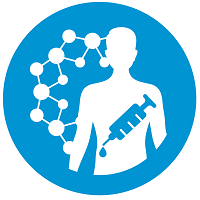Preclinical, Clinical, and Translational Sciences
Symposium: Translational Development of Diverse Drug Formulations
Harnessing In Vitro Models for NAMs-Based Inhalable Substance Safety Assessments
Wednesday, November 12, 2025
9:00 AM - 9:30 AM CT
Location: 225 AB

Erin A. Huber, PhD (she/her/hers)
Respiratory Research Scientist
RTI International
Durham, North Carolina
Speaker(s)
The utilization of differentiated primary cell-based co-culture models of the human respiratory tract have had slow progression to be implemented into the inhaled pharmaceutical drug sector. While commonly used in toxicological assessments, these complex in vitro systems provide opportunities to further our understanding and assessment of inhaled test article exposures on human health. Through the incorporation of differentiated primary human bronchial epithelial cell (dpHBEC) air-liquid interface (ALI) co-culture models in inhaled safety assessments, physiological relevance to humans can be modeled through recapitulation of the bronchial epithelium (mucus production and beating cilia), repeated exposures and long-term treatment studies, and inter-individual variability. However, challenges exist in in vivo-relevant test article delivery to dpHBEC-ALI co-culture models while maintaining physiological relevance.
This presentation will draw from New Approach Methodologies (NAMs) in in vitro inhalation toxicology to encourage incorporation of such methods in drug development evaluations. Dr. Huber will introduce complex in vitro models of the respiratory tract, specifically dpHBEC-ALI co-cultures containing primary human lung fibroblasts and how these models are used for characterizing inhaled chemical exposure effects through three distinct topics. First, inter-individual variability in disease susceptibility and the response to toxicant exposures within the population is driven by the complex interplay of intrinsic factors such as age, sex, race, and the cumulative impact of chemical and non-chemical stressors. Many of these factors cannot be represented by inbred animal strains typically used for pre-clinical studies. To understand whether advanced co-culture in vitro models from human donors capture the heterogenous responses from inhaled exposures, data will be presented from in vivo physiologically-relevant endpoints in a 14-donor population following exposure to acrolein gas. Second, when utilizing in vitro models, the effects, and underlying mechanisms, of inhaled exposures are often modeled using single exposures; however, many inhaled exposures, especially inhaled respiratory drugs, are long-term, causing acute data to lack the appropriate context. This presentation will discuss the amenability of dpHBEC-ALI co-culture models for repeated exposures to inhaled test articles for 5 or 14 days. Third, to achieve physiological relevance, pHBEC cultures differentiate under ALI conditions (i.e. liquid is absent from the apical surface); however, a commonly used dosing methodology known as liquid application dosing applies the resuspended test article in an aqueous vehicle, thus abolishing ALI conditions. This presentation will discuss the impact of liquid application dosing on dpHBEC-ALI cultures through selection of the test vehicle, liquid volume, and time on dpHBEC culture physiology and in vivo-relevant in vitro endpoints.
This presentation will draw from New Approach Methodologies (NAMs) in in vitro inhalation toxicology to encourage incorporation of such methods in drug development evaluations. Dr. Huber will introduce complex in vitro models of the respiratory tract, specifically dpHBEC-ALI co-cultures containing primary human lung fibroblasts and how these models are used for characterizing inhaled chemical exposure effects through three distinct topics. First, inter-individual variability in disease susceptibility and the response to toxicant exposures within the population is driven by the complex interplay of intrinsic factors such as age, sex, race, and the cumulative impact of chemical and non-chemical stressors. Many of these factors cannot be represented by inbred animal strains typically used for pre-clinical studies. To understand whether advanced co-culture in vitro models from human donors capture the heterogenous responses from inhaled exposures, data will be presented from in vivo physiologically-relevant endpoints in a 14-donor population following exposure to acrolein gas. Second, when utilizing in vitro models, the effects, and underlying mechanisms, of inhaled exposures are often modeled using single exposures; however, many inhaled exposures, especially inhaled respiratory drugs, are long-term, causing acute data to lack the appropriate context. This presentation will discuss the amenability of dpHBEC-ALI co-culture models for repeated exposures to inhaled test articles for 5 or 14 days. Third, to achieve physiological relevance, pHBEC cultures differentiate under ALI conditions (i.e. liquid is absent from the apical surface); however, a commonly used dosing methodology known as liquid application dosing applies the resuspended test article in an aqueous vehicle, thus abolishing ALI conditions. This presentation will discuss the impact of liquid application dosing on dpHBEC-ALI cultures through selection of the test vehicle, liquid volume, and time on dpHBEC culture physiology and in vivo-relevant in vitro endpoints.
Learning Objectives:
- Upon completion, participant will be able to develop an understanding of the complexity of primary human cell models of the respiratory tract and their impact in predictive toxicology in humans.
- Upon completion, participant will be able to explore the future potential and use of primary human cell models for inhaled drug development testing.
- Upon completion, particpant will be able to understand the challenges and characterization needed in in vivo-relevant test article delivery to primary human cell models of the respiratory tract.

